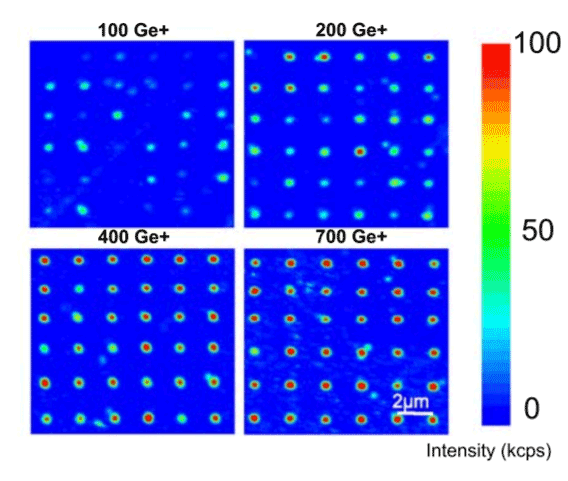
In various materials, single–ion implantations have been proven to serve as solid-state quantum bits and quantum photonics. In search of the ideal qubit, researchers aim for bright narrowband emissions, availability of optical readout, and manipulation of spin states. They therefore explore the benefits of ion species and substrate combinations to improve properties such as Debye Waller factor, long spin coherence times, and ground state splitting.
Publications
Two recent publications from Zheng Liu et al. (https://pubs.acs.org/doi/abs/10.1021/acsphotonics.7b00230) and Igor Aharonovich et al. (https://iopscience.iop.org/article/10.1088/1367-2630/aaf2ac) show the potential of RAITH’s VELION focused ion beam systems to serve as a maskless vacancy maker with high spatial resolution.
Mr Liu and his colleagues studied the effect in terms of optical and spin properties of Si2+ ions implanted into silicon carbide. Photostability was proven to be stable with no blinking or bleaching observable; in addition, the count was stable, which is important for quantum information applications. The average number of defects on a spot where 40 ions were implanted was evaluated as 1.56, with 19 single vacancies out of 50 spots. This gives a single vacancy creation efficiency of about 38% and proves efficient generation of single photon sources, which is necessary for coupling with photonic structures.

“This method offers new possibilities for realizing photonic applications where there is a need to place single or few silicon vacancy defect centers within a nanometer–scale region,” the author stated.
Mr. Aharonovich and colleagues also discovered the great benefits offered by this approach when germanium ions and diamond substrate are used for photonic structures. Using photoluminescence spectrum studies at room and cryogenic temperatures and optically detected magnetic resonance, they proved the emitters to be germanium vacancies. Here the spectrum shows four peaks around 600nm, corresponding to ground and exited states split by spin-orbit coupling. Photostability of Si ion-generated defects was also found to be good. By applying a dose of 200 ions per spot, the probability of creating single emitters was found to be 53%. The number of emitters rises at higher doses, which is “extremely helpful in efficient and deterministic fabrication of single germanium vacancy centers at a spatial precision of tens of nanometers,” Mr. Aharonivich pointed out.
Both papers show how VELION enables new possibilities for realizing placement of single color centers with nanometer-range position accuracy for photonic applications.

